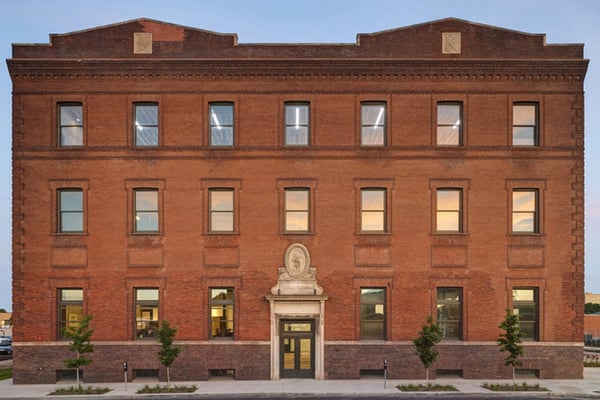Historic rehabilitation projects can be costly and unpredictable. Fortunately, the Federal Historic Preservation Tax Incentive Program helps reduce the financial risk. The program is designed to encourage the redevelopment of historic structures and augment tax revenue for state and local governments.
At Neumann Monson, we have worked on numerous projects that utilize historic tax credits. Market One in Des Moines—a COTE Top Ten Award winner—received tax credits while achieving near-net zero energy performance.
Initially, the application may seem daunting. With multiple government agencies involved, you may feel lost in red tape. We are here to help. The application process is broken into three main steps:
- Determining the building’s eligibility
- Submitting a description of rehabilitation
- Finalizing the application
In this article, we review these steps and discuss what you will need to invest to be approved.
1. Determining a Building’s Eligibility
The first step determines the building’s eligibility for tax credits. In most cases, you will begin by hiring an architect and historian to research the building and its significance. Working with the historian, the architect submits drawings of the existing structure to the State Historic Preservation Office (SHPO) who reviews the application and forwards it to the National Park Service (NPS) with a recommendation.
If the NPS approves the application, the building becomes a “certified historic structure,” making it eligible for historic tax credits. Buildings listed on the National Register of Historic Places are automatically counted as “certified historic structures,” along with buildings that are “contributing resources” in historic districts. “Contributing resources” are buildings that add to the district’s historical or architectural significance. Generally, they date to a particular period.
If the building does not fall into one of these two categories, you can apply for a “preliminary determination of significance” directly with the NPS. This allows the NPS to continue with the application and review part two. Preliminary determinations are not binding, and eventually, the building will need to be on the National Register to receive tax credits. The building owner will need to contact the State Historic Preservation Office and obtain a listing.

Market One in Des Moines, a project that received historic tax credits.
2. Submitting a Description of Rehabilitation
In the second step, the NPS reviews the design plans and determines if the work to be done aligns with the Secretary of the Interior’s Standards for Rehabilitation. Architects will submit schematic designs to the SHPO who will advise on applications, provide technical assistance, and recommend appropriate rehabilitation treatments.
After, the SHPO will forward the application documents—known as the Description of Rehabilitation—to the NPS. If the proposed work does not match the Standards for Rehabilitation, the project will be rejected. To gain approval, the owner and architect will have to change the design plans and resubmit.
Financial Readiness
The NPS will also evaluate the project’s financial readiness. By this point, the architect should have completed all design work and the client should own the property. The client must also secure all other means of financing and have a contractor in place. If these requirements are met, the NPS will estimate an amount for the tax credit.
Keep in mind: Historic tax credits are worth 20% of the costs of rehabilitating the building. Check out our explanation of historic tax credits to learn what expenses qualify.
3. Finalizing the Application
The application’s final step occurs after construction is complete. In this phase, the NPS determines if the completed project aligns with the approved Description of Rehabilitation. The architect will apply with the SHPO who forwards the application to the NPS.
If the completed work matches the approved Description, the IRS will issue a 20% tax credit. Tax credits will only be granted if the project aligns with the Standards of Rehabilitation. Be sure to consult an experienced architect who understands the nuances of these requirements.
Upfront Investments
As you head into the application process, know that historic tax credits are not free money. Applying requires an upfront investment. Depending on the project, you may be expected to invest between $70-80,000 for drawings, design work, and historical research before you reach the application’s third step. However, you will likely earn back your investment (and more) through tax credits.
Consulting an Architect
If you plan to apply for historic tax credits, be sure to start the application as early as possible. Involving an architect early in the process assures you have the tools and expertise you need to complete the first phase of the application, setting you up for success in later phases. To understand what it is like to work with an architect, check out our guide to the architectural process.
